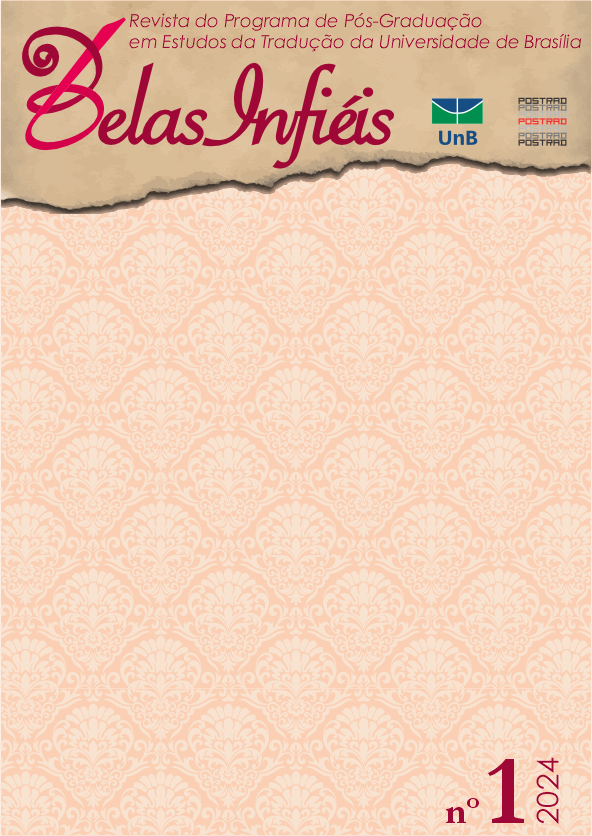O uso de notas de tradutor em quatro traduções de “Miramar”, de Naguib Mahfuz
DOI :
https://doi.org/10.26512/belasinfieis.v13.n1.2024.51312Mots-clés :
Estudos da Tradução. Paratexto. Quebra de linearidade. Literatura egípcia. Literatura árabe.Résumé
O romance Miramar (1967), de Naguib Mahfuz, retrata a sociedade urbana egípcia após a Revolução de 1952 e está repleto de referências sociais, políticas e culturais. Esse tipo de informação gera problemas tradutórios que podem ou não vir a ser resolvidos via nota de tradutor. Analisando quatro traduções da obra, para o inglês, espanhol, português brasileiro e português de Portugal, percebe-se que as escolhas tradutórias variaram significativamente, revelando muito sobre cada tradutor/a, o sistema literário em que se inscreve e sua relação com o Egito. Com o objetivo de investigar o uso da nota de tradutor em cada uma das traduções, mobilizamos discussões teóricas sobre o assunto, especialmente as suscitadas por María Luisa Donaire Fernández (1991) e Pascale Sardin (2007). Conclui-se que, na tradução para a língua inglesa, a quebra da linearidade do texto principal é evitada, sendo o único que não utiliza paratextos. Nas outras três traduções, observa-se maior utilização de paratextos, sejam eles um prólogo na edição espanhola, que suprime a necessidade de algumas notas da tradutora, ou um maior uso de notas de tradutor, no caso das duas traduções para o português. Tais notas, com maior frequência, cumprem função exegética, podendo também adicionar um teor interpretativo. Em nenhum dos casos estão presentes estratégias de explicitação do/a tradutor/a como autor/a, tais quais reflexões metalinguísticas. A partir dessas conclusões, comparadas com a observação do mercado editorial em cada um dos países envolvidos, levantam-se hipóteses sobre quais práticas tradutórias são mais facilmente aceitas em cada cultura.
Téléchargements
Références
Cardellino Soto, P. (2015). Abordagens normativas e descritivas às notas do tradutor dos anos 1960 até o presente: excertos de uma revisão bibliográfica. Belas Infiéis, 4(2), 89–96. http://periodicos.unb.br/index.php/belasinfieis/article/view/11338
Fernández, M. L. D. (1991). (N. del T.): Opacidad lingüística, idiosincrasia cultural. In M. L. D. Fernández, & F. Lafarga (Eds.), Traducción y adaptación cultural: España–Francia (pp. 79–91). Universidad de Oviedo, Servicio de Publicaciones. https://dialnet.unirioja.es/servlet/articulo?codigo=1113088
Kassai, G. (1994). Pour un dictionnaire des connotations construit sur les notes du traducteur. Studi Italiani di Linguistica Teorica ed Applicata, 23, 509–521.
Mahfouz, N. (1978). Miramar (F. M. Mahmoud, Trad.). Anchor Books.
Mahfuz, N. (1990). Miramar (F. M. Mahmoud, Trad.). Three Continents Press.
Mahfuz, N. (2002). Miramar (I. Hervás Jávega, Trad.). Círculo de Lectores.
Mahfuz, N. (2003). Miramar (S. A. C. Jubran, Trad.). Berlendis & Vertecchia Editores.
Mahfouz, N. (2012). Miramar (B. Hassanein, Trad.). Civilização.
Newmark, P. (1987). A textbook of translation. Prentice Hall.
Nida, E. A. (1964). Toward a Science of Translating: With Special Reference to Principles and Procedures Involved in Bible Translating. E. J. Brill.
Rónai, P. (1976). A Tradução vivida. Educom.
Sardin, P. (2007). De la note du traducteur comme commentaire: entre texte, paratexte et prétexte. Palimpsestes, 20, 21–136. https://journals.openedition.org/palimpsestes/99
Téléchargements
Publié-e
Comment citer
Numéro
Rubrique
Licence
(c) Tous droits réservés CC BY 2024

Cette œuvre est sous licence Creative Commons Attribution 4.0 International.
Copyright Statement
Given the public access to this journal, the texts are free to use but requires the recognition of the original authorship and initial publication in this journal to be properly stated.
The journal allows the use of works published for non-commercial purposes, including the right to submit the work to publicly accessible databases. Published contributions are the sole and exclusive responsibility of the author(s).
- When submitting papers to be evaluated by the Belas Infiéis journal, the author(s):
- Declare that the contents of the contributions are original and of their original creation, being entirely responsible for their content if there is an objection by third parties.
- Claim to be aware that they should not commit academic plagiarism.
- Declare that the manuscript has not been published, completely or partially, in Portuguese or another language. If it is a translation it should be submitted to the Translated Articles section.
- Declare that the manuscript is not being evaluated by other journals.
- Declare that the manuscript was not submitted to another journal simultaneously.
- Commit(s) to inform the journal of any kind of error or inaccuracy in their contribution (published, in evaluation or in editing) and to collaborate with the editors to make due corrections of the article (when in evaluation or editing) or erratum/retraction (after publication).
- Declare that there is no conflict of interest regarding the published work.
- Authorize its release if it is accepted for publication without any kind of monetary compensation.
- Agree to assign non-exclusive rights to publication to the magazine, remaining free to make their contribution available in other media as long as the publication of the first version in Belas Infiéis magazine is mentioned. They also authorize Belas Infiéis to assign their texts for reproduction in content indexers, virtual libraries and similar platforms.
- Maintain copyright and grant the journal the right of first publication, the work being licensed under theCreative Commons Attribution License.
- Is/Are allowed and encouraged to publish and distribute their work online after the editorial process, which may increase the impact and citation of the published work.
- Authorize the editorial team to make textual adjustments and to adapt the article to the publication rules, when necessary.



















